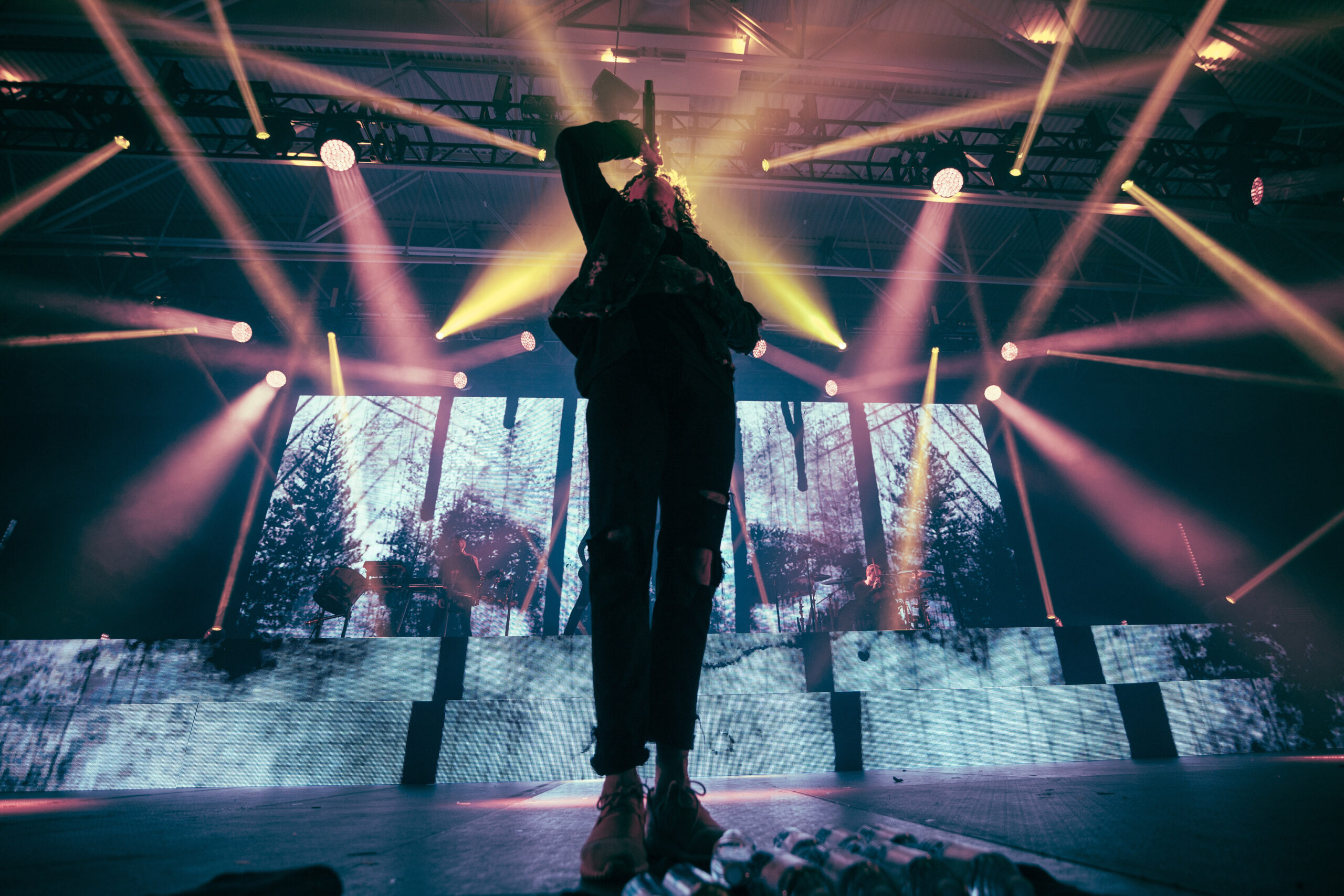
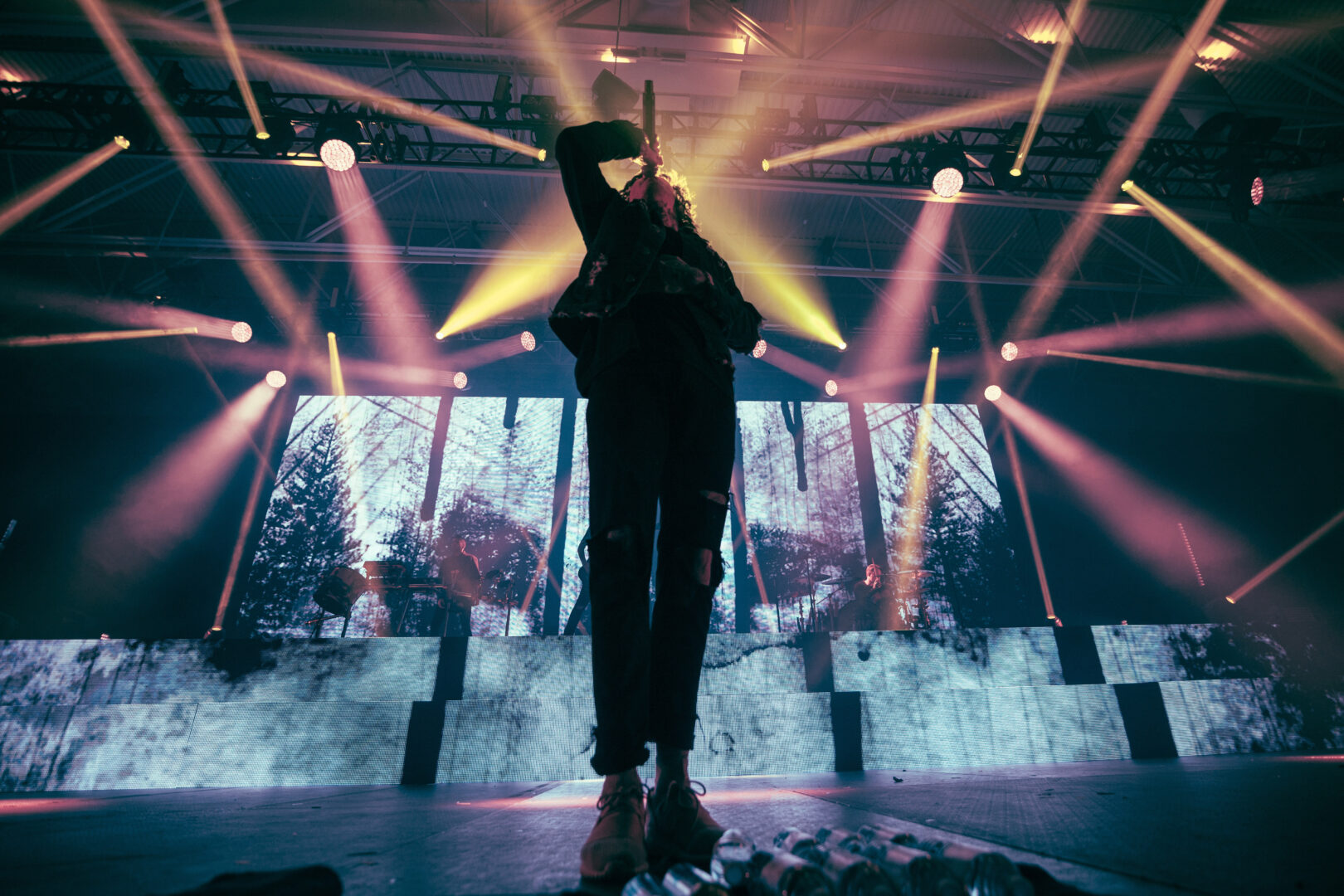
Beguiling the Crowd: The Art of Powerful Stage Presence
Every performer knows the magical moment when they first take to the stage. Freddie Mercury encapsulated this feeling: ‘The bigger the audience, the better it is. It’s like the more the merrier. I adore it, it makes me feel alive.’ However, the true magic lies not in the circumstance, but in the charisma of the entertainer—their stage presence. Believe it or not, great stage presence is more than just talent or showmanship. It’s the unique connection one makes with their audience, the magic that keeps spectators rooted in their seats, their eyes glued on the stage like they’re hypnotized.
To command a room and keep an audience on the edge of their seat is no easy feat. It requires more than just talent or proficiency in your art; it requires an artist to be comfortable in their skin, confident in their abilities, and present in the moment. The goal of every performer should not just be to put on a great show, but to cultivate a better presence—a unique, personable energy that captivates and connects with the audience. This is what transforms an ordinary show into an unforgettable experience.
The Importance of Stage Presence and Body Language
At its core, stage presence is about energy. It’s about the connection between the artist and their audience. It’s the mysterious quality that makes an audience feel like they’re part of the performance. Contrary to popular belief, you don’t have to be naturally charismatic or extroverted to exhibit great stage presence. Even the most reclusive and intimate performers can harness this skill with some effort and practice.
One of the key components is the performer’s stage persona. Essentially, this is an extension of their personality, crafted to connect with the audience on a deeper level. This persona can sometimes be quite different from how the performer is offstage, but it doesn’t make it any less authentic. Rather, it provides an opportunity to channel a different aspect of one’s identity that may not usually get a chance to shine.
The presence of an artist performing on stage also extends to their cooperation with their bandmates, if any. The interplay of energy between band members can truly lift a performance from good to memorable. Remember, it’s not just about your individual performance but about how you contribute to the overall stage performance of your band. Elicit their help in maintaining the stage energy. Encourage them not only to play their instruments but also to interact with the audience, create visual cues, and participate in the show. This contributes to a unified, high-energy performance that can be quite infectious. Shared looks of excitement at a perfectly executed riff, or a collective take a deep breath before a complex tune, can transform your performance from a routine set to a live show spectacle that captivates your audience. A cohesive band that’s in sync with each other and having fun on stage radiates a palpable energy that the audience picks up and responds to, further enhancing the performance.
Another key component often overlooked in mastering stage presence is body language. Your body language can communicate volumes about your persona on stage. Everything—from your posture to your gestures plays an integral role in conveying your energy and emotion to the crowd. Key is to be mindful not to give the audience a break to switch off by maintaining a consistent energy level and giving your all, regardless of whether you are the focus at any given moment.
Studying the Greats: How to Emulate Your Idols
Studying and Emulating the Original Band’s Stage Presence
In the music industry, any successful performer will tell you that their journey consisted of critical observation and emulation of their idols. It’s not about imitation; rather, it’s a strategy to pick up and refine skills from the best in the business.
This begins by understanding the personas of great artists you admire, whether it’s their captivating charm, emotive prowess, or their unmatched on-stage energy. Observing how they connect with their audience, hold command on the stage, or portray their persona can provide invaluable tips.
Fortunately, in today’s digitally-accessible age, observing performances isn’t limited to concerts and live shows. Immersing yourself in the videos, interviews, and behind-the-scenes of renowned performers can yield insightful nuggets. Watch how they move, interact with the band, or engage with the crowd. Notice the subtleties—how they control silences, how they project their voice, how they make the audience feel like they’re part of the performance.
Ultimately, the audience doesn’t want to see a tepid impersonation of an original performer. They want authenticity. They can’t get enough of a performer who channels their inspirations but still brings their unique energy and interpretation to the stage—creating a unique stage persona that resonates deeply. Remember, as you work on improving your stage presence, take the time to incorporate what you’ve studied and adapted into your performances, keeping what fits your style and discarding what doesn’t—that is the true art of performance.
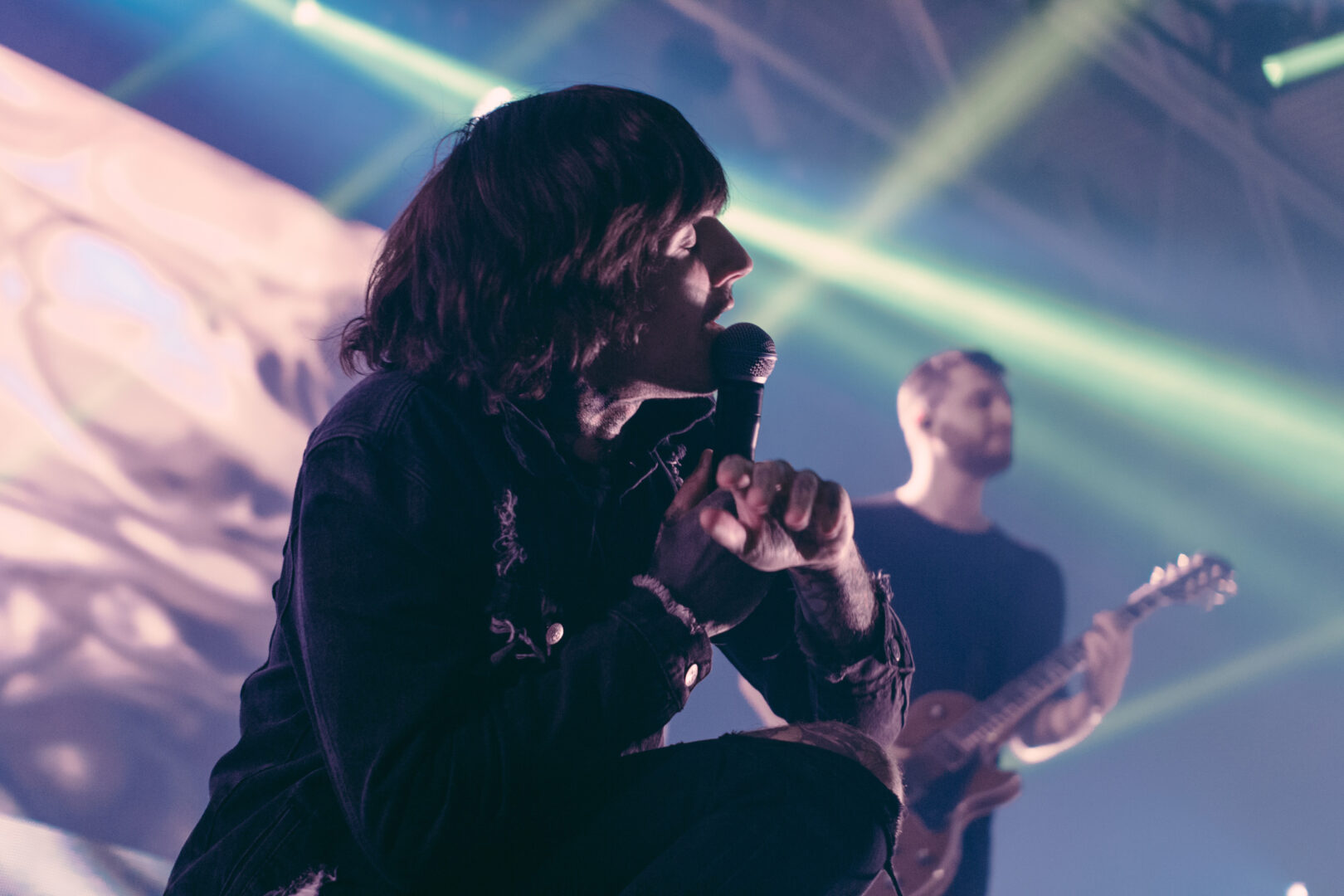
crouching singer
Commanding the Stage: Tips to Improve your Stage Presence
Involve the Crowd: Silence and the Ability to Hold and Mesmerize Your Audience
When it comes to improving your stage presence, many performers put all their focus on their musical talent. But remember, music is only part of the performance. Lady Gaga once said, ‘When I’m performing, I’m not thinking. I’m feeling.’ You are not just playing music for your audience; you are inviting them into your world. For this reason, including your audience in the show is one of the most effective ways to connect with them and improve this important skill.
Don’t be afraid to move around the stage, interact with your band members, and bring your songs to life through theatrical elements. Not only does this create a more dynamic performance, but it also provides a visual representation of the music, helping the audience connect to the narrative of your show. Remember to control your body language. Stand tall, make eye contact, connect with your audience and use powerful yet simple gestures to illustrate your music’s emotional texture.
Silence, too, is a powerful tool. A well-placed pause can make your audience hang on your every word—quite literally. It builds anticipation, heightens emotion, and adds dramatic effect. Just like in real conversations, silence on the stage can convey a wealth of emotions. Whether it’s rock bands or jazz troupes, the most seasoned performers leverage silence as a potent tool to build suspense, create anticipation, or to simply let a powerful note reverberate. Owning these silent moments on the stage can create an aura of confidence and intrigue around your persona, ramping up your stage performance.
Whether you’re performing in intimate settings or live show arenas, the ability to make your audience feel part of your musical journey is what will separate you from the crowd, enhancing your stage presence in ways that techniques and tutorials cannot. Be present, be authentic, and most importantly, bring your passion for music to the fore.
Part of a Great Show: Audience Interaction and Keeping Energy High
Managing Stage Anxiety: Keeping Calm and Confident
For every performer, managing stage anxiety is paramount to displaying a captivating performance. Beyoncé once said, ‘I get nervous when I don’t get nervous. If I’m nervous I know I’m going to have a good show.’ Embrace the heightened emotions and adrenaline rush as pre-show jitters—they’re indicators of your dedication and commitment. Convert these heightened feelings into positive energy to fuel your performance, ensuring you look confident and in command.
Steve Tyler once said, “The best performances are when you lose yourself. The better the band gets, the more captivating the performer gets, the less they feel like a persona and more they feel like themselves.” As you step onto the stage, remember these sage words and allow yourself to be vulnerable. Let your audience witness your authenticity; it’ll make your performance more compelling and endearing. To combat stage anxiety, focus on engaging with your audience members. It can boost your confidence and create a greater connection with them.
A seamless set list is crucial for maintaining an energetic stage performance. The less downtime between songs, the more engaged your audience will stay. Rehearse your band set thoroughly and devise cues that ensure all band members stay in sync, enhancing your performance. Add seamless transitions from one song to the next song without an awkward silence, have prepared stories to keep the audience engaged. Remember – a well-coordinated set not only makes you look professional, but also allows you to keep the energy levels high and ensures your audience remains immersed in the performance.
Ideally, you should maintain a balance between banter and silence. Banter is a great way to engage your audience and show your personality. But remember, the spotlight’s on you—the audience is there to see a great performance, not to end up in a monologue.
Improving through Review: Watch Yourself Perform
Developing Your Unique Style
In the music industry, getting better as a performer often involves stepping back and observing oneself. This doesn’t only involve introspection but literal observation. Cue video recordings of your performances. To significantly better stage presence, a highly recommended practice is to watch yourself perform. This may feel awkward initially but can prove incredibly enlightening.
Now, how do you go about it? Set up a camera during your band rehearsals and film your performances. The idea isn’t to capture professional footage for a music video, but rather to have a bird’s eye view of how you come across on stage. Strong stage presence, after all, is as much about perception as it is about persona and performance.
When you watch videos of your performances, look beyond just the vocals or instrumentals. Keep an eye out for areas of improvement in your stage presence—your interaction with the audience, the way you move on stage, your rapport with your bandmates etc. By reviewing these tapes, you get valuable insights that you wouldn’t have noticed in the heat of the moment on stage.
Additionally, using these videos can aid in practical aspects like deciding when to start the next song. Smooth transitions are key to maintaining audience engagement and energy levels. It becomes easier to spot awkward silences or unnecessary banter that you thought was filling space creatively. With a video, you will clearly see what you need to cut out or keep. As they say, the camera never lies—the spotlight on you, through a lens, will help you level up your performances and become a more captivating performer. This is how you develop your style, all while enhancing your stage presence.
What Makes You Unique: Honing your Unique Stage Style
Stage Presence and Stage Performance Tips
Every performer brings their unique flavor to the stage. Doubling down on your uniqueness can often be the difference between being a decent performer and a memorable one. And the first step to doing that is defining your stage persona. To truly transform a fan into a super fan, you need to present an authentic, immersive portrayal that resonates. Your individual persona should be a compelling blend of your personality markers, musical influences, and storytelling prowess, all channeled into a magnetic stage presence.
Being consciously aware of your uniqueness and repeatedly bringing it to the stage is crucial. It’s imperative to learn from other performers, but you don’t want to lose your unique touch in the process. You can certainly adopt various tips for improving your stage presence, but always iterate those tips in your style. Experiment, refine, and iterate until you find what works for you and feels authentically yours.
Your distinctive stage style—layered with your deep-rooted understanding of your stage presence, your unflinching command over silences, your heightened collaboration with your bandmates, and your spectacular live show execution—can amplify your stage performance from being simply good to being unforgettable. Remember, stage craft and musicianship go hand-in-hand on the path to becoming a standout performer.
Developing a compelling stage presence is a skill that can be honed through specific exercises and training. This segment of the article presents a suite of practical techniques designed to strengthen a performer’s stage presence. It ranges from fundamental breathing exercises, which aid in maintaining composure and vocal strength, to posture improvement drills that foster a commanding physical presence. Additionally, improvisational activities are suggested to enhance spontaneity and audience engagement skills. These exercises are intended to be adaptable, allowing performers from various disciplines to incorporate them into their regular training routines, thus elevating their ability to captivate an audience.
Know Your Audience: The Key to a Captivating Live Show
Mastering audience dynamics is an art form essential to elevating your stage presence. It’s about tuning into the unique energy and preferences of each audience, transforming your performance into a captivating experience.
Begin by reading the room. Gauge whether your audience is craving an electrifying, high-energy show or a more intimate experience. Adapting to their mood can significantly amplify the impact of your performance. Connect with your audience not just through your music but through direct engagement. Eye contact, personal addresses, or even involving them in your performance can create a lasting bond, turning your show into a memorable event.
The setting plays a crucial role too. In smaller, more intimate venues, a storytelling approach can create a warm, personal atmosphere. Conversely, larger venues often call for a more dynamic and expansive performance to fill the space and energize the crowd.
Incorporating humor and storytelling adds layers to your show, making it more relatable and engaging. These elements break down barriers, allowing your audience to connect with you on a deeper level. Being perceptive and responsive to how the audience reacts during your show demonstrates your commitment to not just perform at them but with them. This adaptability can greatly enhance the audience’s experience.
Encourage participation to add an interactive dimension to your performance. Invitations for audience participation, such as sing-alongs or clapping along, create an immersive experience that can elevate the energy levels of the entire room.
By embracing these elements, you’re not merely performing; you’re creating an immersive and shared experience. Each performance becomes an opportunity to create a deep, emotional bond with your audience, leaving a lasting impression and making each show unique and unforgettable.
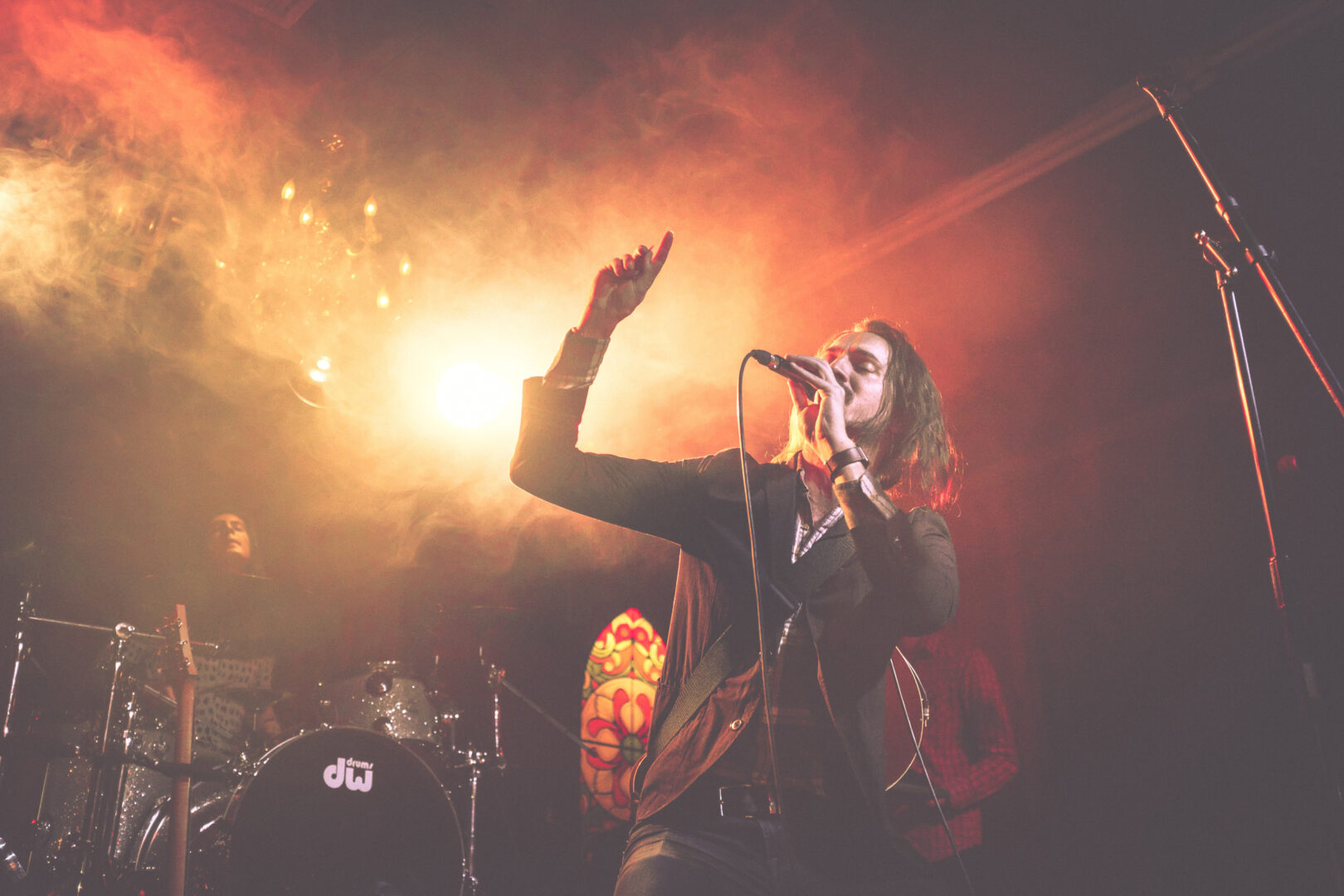
music singer 1
Encore: Quick Recap of Stage Presence Essentials
Stepping on to the stage as a performer can feel like bracing for a rollercoaster ride—the adrenaline is pumping, the eyes of expectant fans are on you, and the atmosphere is charged. What happens next can influence whether your stage performance resonates and stays etched in the memory of the audience.
As we conclude our journey, let’s recap the essential tips in a quick-reference guide. Keep these points in mind as you step onto the stage to ensure a captivating and unforgettable performance:
- Embrace Your Authentic Persona: Amplify your unique personality on stage. Your individuality is not just a trait, but your superpower in creating a memorable presence.
- Engage with the Audience: Establish a strong connection by making eye contact, directly addressing the audience, and inviting their participation. Remember, your performance is a conversation, not a monologue.
- Control Your Body Language: Convey your emotions and the energy of your performance through deliberate posture and meaningful gestures. Your physical expression is a silent yet powerful form of communication.
- Manage Stage Anxiety: Embrace a ‘present in the moment’ mindset. Use deep breathing to ground yourself, and channel any nervous energy into a positive and dynamic performance.
- Study and Learn from the Greats: Observe successful performers. Adapt their techniques to fit your style, learning how they engage audiences, command the stage, and express their artistry.
- Use Silence Effectively: Utilize pauses strategically to create suspense, emphasize emotional moments, and deepen the impact of your performance.
- Collaborate with Bandmates: Create a harmonious and energetic onstage dynamic with your band. A united performance elevates the overall experience for the audience.
- Adapt to Your Venue and Audience: Tailor your act to resonate with the specific setting and audience mood. From intimate venues to large arenas, each performance should feel personalized and engaging.
- Express Gratitude: Show genuine appreciation towards your audience and fellow musicians. Acknowledging their contribution enhances your connection and leaves a lasting positive impression.
- Continuously Review and Improve: Regularly review recordings of your performances. Use these insights to refine your style, stage presence, and interaction with the audience.
- Dynamic Movement: Elevate your performance with energetic and purposeful movements. Your physicality on stage—from pacing to gestures—should complement and amplify the energy of your music, captivating the audience and owning the space.
Refer back to this summary whenever you need a quick reminder of the fundamental aspects of powerful stage presence. Remember, each performance is an opportunity to connect, inspire, and leave a lasting impact on your audience.
In the Spotlight: Embracing Your Performer Persona
Always remember that your live performance is more than the music you play. It’s also about the energy and charisma you radiate on stage. It’s about creating a dynamic, multifaceted experience that deeply resonates with the audience. This involves not just a mastery of your craft, but also a genuine connection with those you are performing for, marked by authenticity and engagement.
A powerful stage presence is built through a combination of being present in the moment, leveraging your unique style, and effectively using body language to communicate with your audience. It’s about understanding and empathizing with your audience, creating performances that are not only seen and heard but profoundly felt.
Ultimately, it is a journey, not a destination. It’s an ongoing process of growth, experimentation, and self-discovery. As Bruce Springsteen eloquently stated, “The audience is not at your concert to hear music. They’re there to feel something.” Embrace this philosophy as you continue to develop your act, remembering that what truly sets performers apart is not just skill, but the authenticity and passion they bring to every performance. Step onto the stage not just as a musician, but as a storyteller, an entertainer, and a connector, fully equipped to leave a lasting impression on your audience.

 San Diego’s Doves of Peace Take Flight with DC Studios and James Gunn’s Peacemaker
San Diego’s Doves of Peace Take Flight with DC Studios and James Gunn’s Peacemaker  Stop the Merch Cuts: Why Touring Bands Should Refuse to Pay Venue Merchandise Fees
Stop the Merch Cuts: Why Touring Bands Should Refuse to Pay Venue Merchandise Fees 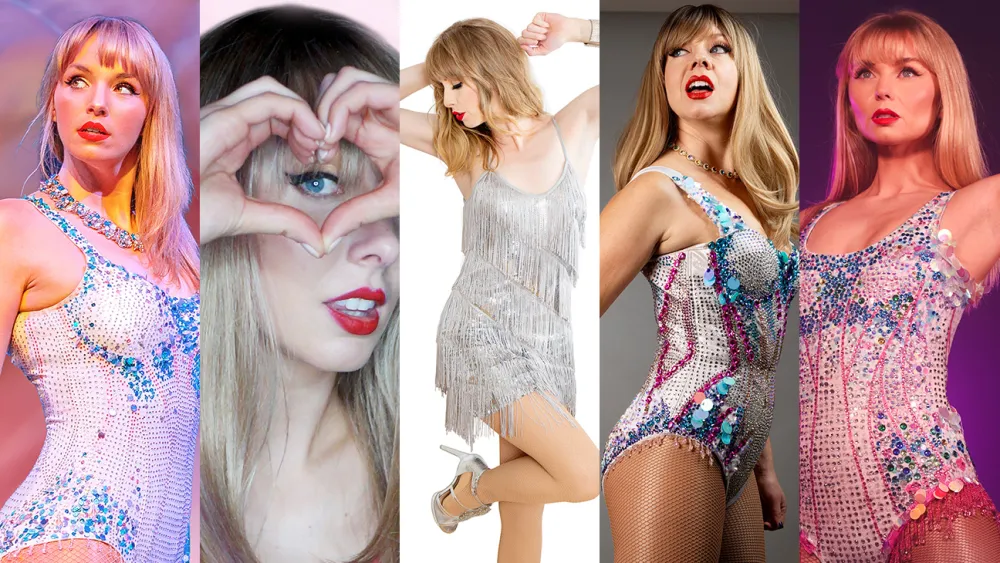 The Lucrative Business of Becoming Taylor Swift
The Lucrative Business of Becoming Taylor Swift  4 Reasons Why Your Tribute Band or Cover Band Should Be Using Vimeo, Not Youtube
4 Reasons Why Your Tribute Band or Cover Band Should Be Using Vimeo, Not Youtube